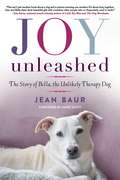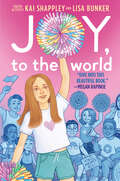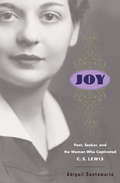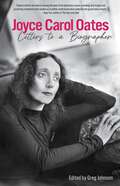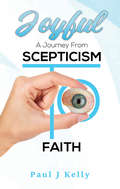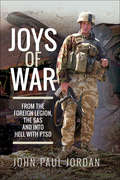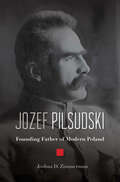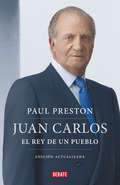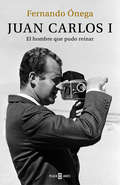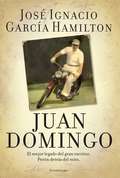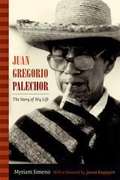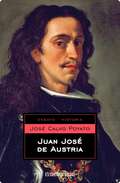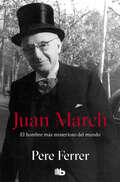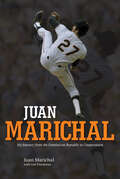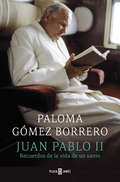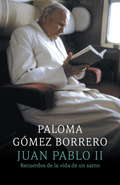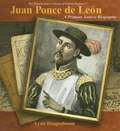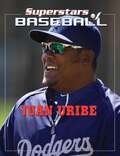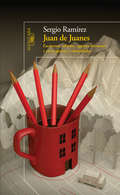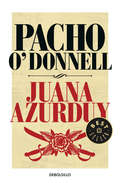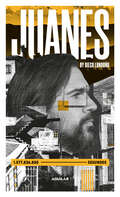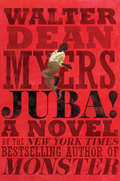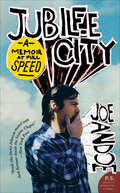- Table View
- List View
Joy Unleashed: The Story of Bella, the Unlikely Therapy Dog
by Jean Baur Aimee ScottIn 2007, Mary Eldergill, a volunteer member of Amigos de Los Animales (Friends of the Animals), discovered a group of newborn puppies on Dead Dog Beach in Puerto Rico. Mary rescued and rehabilitated them and, three months later, they flew to Newark, New Jersey, to be placed in their forever homes. Jean Baur and her husband adopted one of Mary’s rescues?a dog named Bella?and opened her Pennsylvania home to her new best friend. Just as Jean enrolled Bella in certified therapy-dog classes, she lost her job at the age of sixty-five. This new work, visiting hospital patients with her therapy job, gave Jean hope and a new purpose in life. After moving to Connecticut, Bella’s work expanded to nursing homes and elementary schools, as well as local hospitals and cancer centers. She met an Alzheimer’s patient who learned to smile again after Bella took a treat from her hand. She also befriended a six-year-old boy with autism (who previously held a deep fear of dogs) along with a disabled hospital patient who was withdrawn and uncommunicative until Bella jumped into the bed with him and coaxed him to open up again. Jean and Bella’s journey into the world of therapy-dog work gave them a bright, new outlook?and has helped countless others overcome their own struggles?while proving to all that broken souls can, indeed, be healed.Joy Unleashed is a must-read for anyone who appreciates the true power of the human-canine bond.
Joy, to the World
by Lisa Bunker Kai ShappleyA young Dumplin’ meets Melissa in this joyful and energetic middle grade novel about a twelve-year-old girl living her life to the fullest, celebrating her love for sports and fighting for her right to cheer.Joy, a twelve-year-old trans girl, just moved to Texas with her mother and older brother. Her family has accepted Joy as the girl she is early in her transition, with little fuss, leaving Joy to explore her love of sports, competition, teamwork, school spirit, and worship.But when she is told she’s off the cheerleading team, Joy wants to fight for her right to cheer. As her battle with the school board picks up momentum, Joy attracts support from kids all around the country . . . she even gets the attention of her hero, trans activist Kai Shappley.Inspired by Kai’s own life, Joy, to the World is a timely story of living life to the fullest, celebrating and centering trans joy, courage, and resilience.
Joy: Poet, Seeker, and the Woman Who Captivated C. S. Lewis
by Abigail Santamaria&“A lush Narnia tale for grownups&”: The first comprehensive biography of the rebel thinker who married C. S. Lewis (Megan Marshall, Pulitzer Prize winner). If Joy Davidman is known at all, it&’s as the wife of C. S. Lewis, author of The Chronicles of Narnia. On her own, she was a poet and radical, a contributor to the communist journal New Masses, and an active member of New York literary circles of the 1930s and &’40s. Growing up in a family of Jewish immigrants in the Bronx, she became an atheist, then a practitioner of Dianetics, and finally a Christian convert after experiencing a moment of transcendent grace. She was also a mother, a novelist, a screenwriter, and an intelligent, difficult, and determined woman. In 1952 she set off for England to pursue C. S. Lewis, the man she considered her spiritual guide and her intellectual mentor. Out of a deep friendship grounded in faith, poetry, and a passion for writing grew a timeless love story, and an unforgettable marriage of equals—one that would be immortalized in the film Shadowlands and Lewis&’s memoir, A Grief Observed. &“Plumbing the depths of unpublished documents, Santamaria reveals the vision and writing of a young woman whose coming of age in the turbulent thirties is both distinctive and emblematic of her time&” (Susan Hertog, author of Anne Morrow Lindbergh: Her Life). Finally, Joy Davidman is brought out of her husband&’s shadow to secure a place in literary history that is both a long-time coming and well-deserved. &“This book gives Davidman her life back. . . . Ms. Santamaria succeeds in de-mythologizing Davidman&’s story.&” —The Wall Street Journal &“Compelling . . . clear, unsentimental.&” — The New York Times Book Review
Joyce Carol Oates: Letters to a Biographer
by Joyce Carol OatesThis rich compilation of Joyce Carol Oates's letters across four decades displays her warmth and generosity, her droll and sometimes wicked sense of humor, her phenomenal energy, and most of all, her mastery of the lost art of letter writing. "It's hard to think of another writer with as fecund and protean an imagination as the eighty-five-year-old Joyce Carol Oates, who is surely on any short list of America's greatest living writers." —New York Times Magazine In this generous selection of Joyce Carol Oates's letters to her biographer and friend Greg Johnson, readers will discover a never-before-seen dimension of her phenomenal talent. In 1975, when Johnson was a graduate student, he first wrote to Oates, already a world-famous author, and drew an appreciative, empathetic response. Soon the two began a fairly intense, largely epistolary friendship that would last until the present day. As time passed, letters became faxes, and faxes became emails, but the energy and vividness of Oates's writing never abated. Her letters are often sprinkled with the names of famous people, from John Updike and Toni Morrison to Steve Martin and Jacqueline Kennedy Onassis. There are also descriptions of far-flung travels she undertook with her first husband, the scholar and editor Raymond Smith, and with her second, the distinguished Princeton neuroscientist Charlie Gross. But much of Oates's prose centered on the pleasures of her home life, including her pet cats and the wildlife outside her study window. Whereas her academic essays and book reviews are eloquent in a formal way, in these letters she is wholly relaxed, even when she is serious in her concerns. Like Johnson, she was always engaged in work, whether a long novel or a brief essay, and the letters give a fascinating glimpse into Oates's writing practice.
Joyful - A Journey From Scepticism To Faith: A Journey From Scepticism To Faith
by Paul J KellyI have written a raw, frank account of my life, holding nothing back. You will be inspired by my authenticity. This is life with all the highs, lows; the good, the bad and the very ugly. Survival of the fittest they say, character-building stuff they say. Well, see how I survived. My experience in leadership and management, my never-give-up approach and always a desire to have a go, although often failure bit me in the backside. From being in the Devil's camp for most of my life to finding faith. Married at a very young age with a baby on the way, the pressure this brings to bare on both partners. The learnings from being married for over 46 years, the effect of a marriage breakup, then reconciliation. One is always a parent and one always will be there when your kids hit rock bottom, the reader will see why you are always a parent, no matter how old your kids are. What looking in the mirror can do for self-reflection and growth, my learnings from my days as a rugby referee, that helped me develop as a leader. Mostly what and how my faith has dramatically impacted me.
Joys and Sorrows
by Albert Kahn Pablo CasalsCellist Pablo Casals shares his life story, his beliefs and reflections on music.
Joys of War: From the Foreign Legion, the SAS and into Hell with PTSD
by John-Paul JordanA Special Forces veteran and former Legionnaire tells of his military adventures—and of the personal battle that followed him home. In war, John-Paul Jordan was the first to batter down the door, whether he was facing bullets or bombs. In the wake of the 9/11 attacks, the young Irishman set off to join the French Foreign Legion. He would go on to provide security in Iraq, serve his country in Afghanistan, and protect journalists on the front line in Libya. He was decorated for his leadership and bravery—but his biggest fight would come after he left the battlefield. In this memoir he recounts the camaraderie, action, and danger he experienced—and how he later found himself of prisoner of war to PTSD. Dehumanized by the professionals he turned to for help, this Special Forces veteran and former Legionnaire was brought to his knees. His marriage was over; his home was lost. In isolation, his world unraveled, and the seeds of destruction had been well and truly sown. Knowing he would never see military action again and faced with the realization of the war raging within him in the spiral of PTSD, John-Paul felt condemned as a man. But, on April 1, 2016, he surrendered. He asked for help . . . and found the answers within. His story is a testament to the strength of the human spirit: to get back up and to lead from the front. He did not go through all that just to go through all that. This is the story of his return to freedom and joy. Buckle up, because this veteran doesn&’t do anything in half measures.
Jozef Pilsudski: Founding Father of Modern Poland
by Joshua D. ZimmermanThe story of the enigmatic Jozef Pilsudski, the founding father of modern Poland: a brilliant military leader and high-minded statesman who betrayed his own democratic vision by seizing power in a military coup. In the story of modern Poland, no one stands taller than Jozef Pilsudski. From the age of sixteen he devoted his life to reestablishing the Polish state that had ceased to exist in 1795. Ahead of World War I, he created a clandestine military corps to fight Russia, which held most Polish territory. After the war, his dream of an independent Poland realized, he took the helm of its newly democratic political order. When he died in 1935, he was buried alongside Polish kings. Yet Pilsudski was a complicated figure. Passionately devoted to the idea of democracy, he ceded power on constitutional terms, only to retake it a few years later in a coup when he believed his opponents aimed to dismantle the democratic system. Joshua Zimmerman’s authoritative biography examines a national hero in the thick of a changing Europe, and the legacy that still divides supporters and detractors. The Poland that Pilsudski envisioned was modern, democratic, and pluralistic. Domestically, he championed equality for Jews. Internationally, he positioned Poland as a bulwark against Bolshevism. But in 1926 he seized power violently, then ruled as a strongman for nearly a decade, imprisoning opponents and eroding legislative power. In Zimmerman’s telling, Pilsudski’s faith in the young democracy was shattered after its first elected president was assassinated. Unnerved by Poles brutally turning on one another, the father of the nation came to doubt his fellow citizens’ democratic commitments and thereby betrayed his own. It is a legacy that dogs today’s Poland, caught on the tortured edge between self-government and authoritarianism.
Juan Carlos I (edición actualizada): El rey de un pueblo
by Paul PrestonLa edición actualizada de la gran biografía de Juan Carlos I. Hay dos misterios centrales en la vida de Juan Carlos, uno personal, el otro político. ¿Cómo explicar la aparente serenidad con que Juan Carlos aceptó que su padre lo entregara, a todos los efectos, atado de pies y manos al régimen de Franco? En una familia normal, este acto se habría considerado una especie de crueldad o, como mínimo, una desaprensiva irresponsabilidad. Pero una familia real no es «normal», y la decisión de enviar a Juan Carlos a España respondía a una «superior» lógica dinástica. El segundo misterio estriba en cómo un príncipe procedente de una familia con tradiciones autoritarias, obligado a actuar dentro de unas «normas» franquistas, y educado para ser la piedra angular de un complejo plan para la continuidad de la dictadura, se comprometió firmemente con la democracia. Paul Preston, uno de los historiadores que más luz ha arrojado sobrela historia de España en el siglo XX, ha actualizado su gran obra sobre el rey Juan Carlos, en la que aborda las conflictivas relaciones con su padre, su educación encaminada a perpetuar el régimen de Franco, su apuesta por la democracia, su enfrentamiento al golpismo hasta llegar a la plena consolidación de la monarquía parlamentaria y la evolución de la monarquía desde entonces. El resultado es un libro riguroso y escrito con una prosa vibrante que nos ofrece un retrato humano y político del hombre que se propuso ser el «Rey de todos los españoles». La crítica ha dicho...«Una obra espléndida, que a modo de biografía no autorizada, nos ofrece una visión de la España contemporánea.»Marius Carol, La Vanguardia «De lectura obligada para todos cuantos se interesen por nuestra historia más reciente.»Charles Powell, El cultural «Un libro formidable.» Luis María Anson «Una biografía excelente.»Sunday Times «Una obra rigurosa que además es una historia fascinante. Su gran mérito es recordarnos que en medio de todas las batallas dinásticas, las conspiraciones políticas y la especulación de los medios hay un ser humano que a menudo ha estado muy solo.»The Economist
Juan Carlos I: El hombre que pudo reinar
by Fernando ÓnegaEste libro recoge los primeros testimonios de Juan Carlos I tras su abdicación y hace balance de su reinado apoyándose en los recuerdos de aquellos que lo conocieron y trataron de cerca, ahora que los cimientos de aquella Transición parecen tambalearse bajo el empuje de una nueva generación que no reconoce la importancia de su labor al frente de la corona.La figura de Juan Carlos I resume a la perfección las contradicciones del último siglo de historia de este país: nacido en el exilio en Roma durante la Guerra Civil, su ascensión al trono significó el regreso de esa «otra España» derrotada en el conflicto. Nombrado «sucesor a título de Rey» por Francisco Franco, sus primeros pasos sin la tutela del dictador estuvieron dirigidos a desmontar el franquismo que lo había aupado al poder. Y su firme apuesta por la democracia parlamentaria que limitaba sus poderes, consiguió irritar a ciertos sectores del ejército hasta el punto de llevar a cabo sucesivas conspiraciones en contra del rey al que habían jurado obediencia.Fernando Ónega aborda la difícil tarea de retratar al hombre tantas veces retratado, y nos ofrece uno de sus perfiles más personales: el del hombre que pudo reinar.«Nos vamos, ¿no?» Se lo preguntó dos veces, como si necesitara reafirmar el permiso para marcharse. Su hijo hizo un gesto de asentimiento. Y él giró su cuerpo maltrecho, castigado por los años, dolido a causa de los accidentes, la cadera tantas veces rota y las «visitas al taller», y entró en la penumbra del palacio, que era la penumbra de la historia. Se apoyó en su bastón y se desvaneció tras aquella puerta que daba al balcón de la plaza de Oriente.
Juan Domingo: El mejor legado del gran escritor. Perón detrás del mito
by José García HamiltonUna apasionante y lúcida biografía del Perón de carne y hueso: sufamilia, motivaciones, actitudes, gustos, decisiones, su manera de ser yde actuar, los hombres y las mujeres que lo rodearon. Motivado por sus ideales liberales y libertarios, José Ignacio GarcíaHamilton nos acercó la vida de Alberdi, Sarmiento, San Martín y Bolívar.Ahora elige a Juan Domingo Perón. ¿Por qué Perón? Existía en el escritorla íntima y profunda necesidad de investigar sobre la persona que, másde sesenta años después de irrumpir en la vida política argentina eincluso después de su muerte, continúa inspirando y abrigando en unmismo signo político a líderes y seguidores de pensamientos y accionestan disímiles.Desde muy joven, y más aún desde su ingreso al Congreso Nacional comodiputado por su provincia natal, José Ignacio se mostró interesado porentender el movimiento peronista. Las múltiples facetas, muchas de ellasopuestas, enfrentadas o contradictorias, que signan la maquinariajusticialista del poder lo dejaban perplejo. ¿Cómo y por qué losperonistas de las extracciones más diversas pueden sentirse parte de unmismo colectivo y abrazados por una misma praxis? ¿Qué los une? Larespuesta a estos interrogantes no podía sino estar en el origen. Eseorigen es el propio Juan Domingo Perón. El militar, el político, eldeportista, el conductor, el estratega, el seductor, pero, sobre todo,el hombre: la historia de su vida, familia, motivaciones, actitudes,gustos, decisiones, su manera de ser y de actuar, los hombres y lasmujeres que lo rodearon.El autor buscó, como lo hiciera siempre y de manera exitosa, al hombredetrás del mito. Es así como en esta apasionante biografía nos trae,entre tantas otras facetas inéditas, al alumno cuya partida denacimiento es falsificada para ingresar al Colegio Militar, aladolescente que sufre al encontrar a su madre acostada con un peón, aljoven rechazado por su prima Mecha debido a su origen familiar brumoso,además del exitoso político y el líder de las pasiones encontradas.Juan Domingo no es un libro sobre el pasado. La mirada de GarcíaHamilton atraviesa hechos y acciones con una lucidez nueva, producto deaños de intensa búsqueda de la verdad histórica, aquella que permiteiluminar nuestro presente y proyectar un futuro promisorio. Juan Domingoes, sin lugar a dudas, el mejor legado que podía dejarnos el incansableensayista, el divulgador apasionado, el talentoso escritor y el hombreque buscó siempre la verdad.
Juan Gregorio Palechor: The Story of My Life
by Andy Klatt Myriam JimenoThe Colombian activist Juan Gregorio Palechor (1923-1992) dedicated his life to championing indigenous rights in Cauca, a department in the southwest of Colombia, where he helped found the Regional Indigenous Council of Cauca. Recounting his life story in collaboration with the Colombian anthropologist Myriam Jimeno, Palechor traces his political awakening, his experiences in national politics, the disillusionment that resulted, and his turn to a more radical activism aimed at confronting ethnic discrimination and fighting for indigenous territorial and political sovereignty.Palechor's lively memoir is complemented by Jimeno's reflections on autobiography as an anthropological tool and on the oppressive social and political conditions faced by Colombia's indigenous peoples. A faithful and fluent transcription of Palechor's life story, this work is a uniquely valuable resource for understanding the contemporary indigenous rights movements in Colombia.
Juan José de Austria
by José Calvo PoyatoUna de las personalidades más atractivas -y peor conocidas- de nuestro siglo XVII es Juan José de Austria, conocido como don Juan por sus contemporáneos. Era hijo de Felipe V y María Calderón, una de las más famosas actrices de Madrid de aquellos tiempos. Fue don Juan, pues, un bastardo regio, como también su homónimo de un siglo antes, el don Juan de Austria vencedor de los turcos en Lepanto. El origen de don Juan pesó en su vida como una losa, dado que sus expectativas apuntaron a lo más alto en aquella monarquía que veía consumirse, en medio de una profunda crisis, la segunda mitad del Seiscientos. Ser ilegítimo, pese al reconocimiento expreso de su paternidad que hizo Felipe IV, fue un obstáculo insalvable para sus aspiraciones.
Juan March: El hombre más misterioso del mundo
by Pere Ferrer«March entendía que la política solo era una palanca para sacarse del medio aquello que le estorbaba». El personaje que representó March en la vida tuvo muchas facetas novelescas. Se inició en el contrabando, estuvo involucrado en el asesinato de su socio y amante de su mujer (un crimen jamás resuelto), tuvo incontables aventuras amorosas... El doble juego que practicó en las contiendas bélicas del siglo XX le convirtió en uno de los hombres más ricos de Europa. Fue una controvertida figura política: escapó de la cárcel de Alcalá de Henares, donde estuvo preso durante la República; financió la revuelta militar de julio de 1936 y se opuso al general Franco durante los cuarenta, apostando por la monarquía. Y finalmente, de forma rocambolesca, se apropió de la Barcelona Traction y la obra de mecenazgo de la Fundación March. Pere Ferrer relata en estas páginas la biografía de la polémica trayectoria del banquero mallorquín, un hombre ambicioso y brillante, creador del primer emporio de las islas Baleares.
Juan Marichal: My Journey from the Dominican Republic to Cooperstown
by Lew Freedman Juan MarichalThe groundbreaking superstar tells his story: “To look at the MLB career of Hall of Fame pitcher Marichal is to look at another era . . . a solid hit.” —Library JournalIn a decade that featured such legendary hurlers as Sandy Koufax, Bob Gibson, Don Drysdale, and other Hall of Famers, no pitcher won more games than Juan Marichal in the 1960s. His unique high-kick pitching style was imitated by kids from New York to San Francisco to Santo Domingo, and is immortalized in a bronze statue outside of the Giants’ current ballpark. Marichal was the first Dominican-born player to play in an All-Star Game and the first elected to the Baseball Hall of Fame, and he won more games than any of his countrymen. And while Dominican and other Latino players have come to dominate many aspects of baseball in recent years, Marichal was a trailblazer in his day, entering the league at a time when Latin American players were routinely discriminated against, underpaid, and presented with numerous obstacles on their journey to the big leagues.Now, Marichal tells the story of his rise from living on a rural farm as a young boy in the Dominican Republic to his status as one of the greatest pitchers of all time. Along the way, he was enlisted by the son of the country’s dictator to play for the national team, was threatened at gunpoint to throw a game during a tournament in Mexico, fought homesickness as a minor leaguer in rural Indiana, and went head-to-head with some of the best pitchers and hitters the game has ever seen.For the first time, Marichal gives his perspective on life as a Latino ballplayer in the 1960s, describes the highs and lows of a sixteen-year major league career, and explores what the recent influx of Dominicans in the majors has meant to baseball and to his home country—and also offers reflections on lingering stereotypes, the impact of steroids, and the general state of the game in the twenty-first century.
Juan Pablo II: Recuerdos de la vida de un santo
by Paloma Gómez BorreroSolo Paloma Gómez Borrero podía escribir este libro con las anécdotas más íntimas, más cercanas, más simpáticas y sobre todo menos conocidas de la vida del Papa Juan Pablo II. Ella misma fue testigo de las historias y vivencias que nos presenta en este libro. Hay anécdotas que demuestran su lado más humano, más cercano, y otras que nos narran los momentos más serios, dramáticos y trágicos, como el del atentado que sufrió en 1981.Paloma relata también los encuentros que tuvo el pontífice con enfermos, con presos, con famosos, con políticos (y no todos creyentes), y una serie de curiosidades que tuvieron lugar durante los múltiples viajes por todo el mundo.
Juan Pablo II: Recuerdos de la vida de un santo
by Paloma Gómez BorreroUn retrato fascinante de 31 momentos desconocidos en la vida del Papa más querido de los últimos tiempos a punto de ser canonizado. Solo Paloma Gómez Borrero podía escribir este libro con las anécdotas más íntimas, más cercanas, más simpáticas y sobre todo menos conocidas de la vida del Papa Juan Pablo II. Ella misma fue testigo de las historias y vivencias que nos presenta en este libro. Hay anécdotas que demuestran su lado más humano, más cercano, y otras que nos narran los momentos más serios, dramáticos y trágicos, como el del atentado que sufrió en 1981. Paloma relata también los encuentros que tuvo el pontífice con enfermos, con presos, con famosos, con políticos (y no todos creyentes), y una serie de curiosidades que tuvieron lugar durante los múltiples viajes por todo el mundo.
Juan Pablo II: recuerdos de la vida de un santo
by Paloma Gomez BorreroEstaba segura de que sería proclamado santo. Por eso he esperado a que fuera canonizado para escribir este libro, que es un compendio de recuerdos, episodios y anécdotas guardados para siempre en mi corazón y en mi memoria, y que ahora me encanta compartir con quienes lean este libro. El gran sentido del humor y la naturalidad de Juan Pablo II le permitían responder de forma espontánea a las preguntas más curiosas e impensables que se le hacían. Así conquistaba a todos, niños, jóvenes o ancianos, fueran o no creyentes. Cuando era posible iba los domingos a una parroquia de su diócesis donde concelebraba la misa con el párroco y luego se quedaba a charlar. Hablaba con los jóvenes, con los matrimonios y con los niños. También se interesaba por las actividades culturales y deportivas de la parroquia. Durante una visita al barrio de Quarticciolo fue al centro social, una especie de club para las personas mayores, donde se jugaba a la petanca, un juego prácticamente desconocido en Polonia. Aquel domingo Juan Pablo II fue acogido con entusiasmo por los campeones del barrio, que quisieron lucirse con una demostración de sus habilidades. El Papa escuchó las explicaciones sobre el juego y mantuvo una conversación divertida con ellos. El ambiente fue tan distendido y familiar que uno se atrevió a invitar al Papa a que probara con una de las bolas. Juan Pablo II lanzó con fuerza y, claro está, no se lució. A pesar de que la bola se quedó muy alejada del objetivo, todos los presentes aplaudieron y gritaron "¡Buena jugada, Santidad! Bravissimo!". El Santo Padre los miró y les advirtió sonriendo: "Deseo que juegues mejor que el Papa, pero también espero que reces tanto como reza el Papa."
Juan Ponce De Leon: A Primary Source Biography
by Lynn HoogenboomDetails the life and exploits of the Spanish explorer who sailed among the islands of the Caribbean.
Juan Uribe (Superstars of Baseball)
by Tania RodriguezJuan Uribe has come a long way from his roots in the Dominican Republic. He's played in two World Series, and he earns millions of dollars every year. But it's his roots that still make him strong. Uribe is proud of his homeland--and his homeland is proud of him! Read about Juan Uribe's life. Find out what it takes to be a baseball superstar!
Juan de Juanes
by Sergio Ramírez«Para ser un escritor se necesita creer sin vacilaciones en los tesoros escondidos en el fondo de las lagunas y ser sobrino de unos tíos mentirosos; al fin y al cabo, contar no es más que aprender a mentir con aplomo. Mentir, mentir, que de la mentira algo queda.»Esta obra emprende una defensa apasionada de la escritura, la literatura, la memoria y la amistad. Es un compendio de recuerdos, lecturas, anécdotas, hechos memorables... La memoria es también una suerte de homenaje a los amigos que nos han acompañado a lo largo de la vida, aquellos con quienes compartimos la mesa, los libros, los viajes y, en el caso de Sergio Ramírez, la revolución. En el amplio mapa de recuerdos de Juan de Juanes, Sergio Ramírez va trazando la ruta que nos lleva desde sus inicios como escritor, el triunfo de la revolución sandinista en su natal Nicaragua, el premio Alfaguara en 1998, hasta la entrega del Premio Iberoamericano de Letras José Donoso 2011, pocos días antes del suicidio de la única heredera del escritor chileno, Pilar Donoso. En las páginas de Juan de Juanes Sergio Ramírez nos cuenta acerca de personajes memorables en su vida, con quienes quedó en deuda, entre otros Carlos Fuentes, Julio Cortázar, Augusto Monterroso, Gabriel García Márquez, Jorge Luis Borges, Ernesto Cardenal y Juan Cruz, su primer editor y punto de partida de este viaje por Latinoamérica. El autor revive en Juan de Juanes años de vida y de literatura, en los que escritores, editores, agentes literarios y por supuesto nosotros, sus lectores, descubrimos el Juan de Juanes total que llevamos dentro.
Juana Azurduy
by Pacho O'DonnellLa figura fascinante de Juana Azurduy, guerrera del Alto Perú, heroína de la independencia, fue largamente relegada por la historia oficial. Pacho O'Donnell reivindica aquí su lucha, llena de coraje, astucia y entrega. En este libro Pacho O'Donnell rescata a una figura injustamente postergada: la de Juana Azurduy. Repasar la vida de la heroína independentista que combatió en el Alto Perú y que entonces alcanzó el grado de teniente coronela (no hace mucho fue ascendida a generala) cumple con una doble reivindicación. En primer lugar la de las mujeres que, armas en mano, combatieron por nuestra libertad a la par de los hombres. Su figura desmiente el rol secundario que pretendió atribuirles la machista historia oficial, que las retrató dedicadas a coser banderas, donar alhajas y, sobre todo, esperar pacientemente el regreso de sus esposos del campo de batalla. Por el otro lado, O'Donnell pone de relieve la valiente acción de los caudillos altoperuanos, a quienes aún se les debe un merecido reconocimiento por su fundamental aporte a la emancipación de nuestros pueblos. El coraje, la astucia y la generosidad con los que Juana Azurduy llevó adelante la lucha contra el ejército realista no solo son los valores que realzan la proeza independentista, sino aquellos que nuestra Patria hoy nos reclama para superar las épocas de crisis.
Juanes
by Diego LondoñoEl libro oficial de Juanes La vida de Juanes es una canción, o mejor, son miles de canciones volando a toda velocidad en miles de millones de segundos, o en una sola historia. en estas líneas, escritas desde los más lejanos rincones de su memoria, sus recuerdos se hacen palabras e imágenes. juanes, el hombre que ha vendido más de 20 millones de discos, que fue seleccionado por la revista time como una de "las 100 personas más influyentes del mundo", que suma 26 Premios Grammy latinos y tres estatuillas Grammy anglo, y que fue invitado por el dios del rock Mick Jagger para tocar la guitarra al lado de los Rolling Stones, cumple 1.577.836.800 segundos de vida, y los celebra con este libro. Juanes vacía su alma y la irriga en estas páginas para decir "gracias", y para recordarnos -y recordarse a él mismo- que lo mejor está por venir, que aún quedan muchos millones de segundos por vivir. estas son las memorias de un soñador.
Juba!: A Novel
by Walter Dean MyersIn New York Times bestselling author Walter Dean Myers's last novel, he delivers a gripping story based on the life of a real dancer known as Master Juba, who lived in the nineteenth century. <P><P>This engaging historical novel is based on the true story of the meteoric rise of an immensely talented young black dancer, William Henry Lane, who influenced today's tap, jazz, and step dancing. With meticulous and intensive research, Walter Dean Myers has brought to life Juba's story.The novel includes photographs, maps, and other images from Juba's time and an afterword from Walter Dean Myers's wife about the writing process of Juba!red in the North and sent down South as slaves. England offers freedoms that Juba could only dream of in the States, and returning home may prove a dangerous decision. <P><P>This novel is based on a true story, the intricacies of Juba's meteoric rise as an explosive young black dancer brought to life by Walter Dean Myers through meticulous and intensive research.
Jubilee City: A Memoir at Full Speed
by Joe AndoeJoe Andoe is an internationally exhibited painter. His work, hailed by The New Yorker as "cowboy noir with a fashionista twist," is in the collections of the Museum of Fine Arts in Boston, the Whitney Museum of Art in New York, and countless other locations. He is a father. He is a writer. He is sober. That's now.Once upon a time, though, way back in the '70s, Joe Andoe was a delinquent bad boy growing up wild in Tulsa, Oklahoma—drinking, drugging, and driving too fast down a dead-end road. He was one car crash, one overdose away from head-on disaster. His art saved him.A life story told in discrete, arresting snapshots of despair, resilience, creativity, and hope, Joe Andoe's raw, vivid, and utterly original memoir is as striking as his painting. With echoes of Jim Carroll poetic insight and Charles Bukowski grit, yet still uniquely the artist's own, Andoe's literary portrait of his time to date on earth is as powerful as a heavyweight's hook and as spellbinding as a major crack-up on the opposite side of the highway. It is an important work of curiosity and grandiosity; a testament to a young man's resilience and genius and luck that enabled him to survive a life lived wildly out of control; an unparalleled adventure, a rocket ride from the sordid depths of self-destruction to the glorious pinnacles of…Jubilee City
